ECS 100 Topic Exploration Project #1
ECS 100 Topic Exploration Project #2
ECS 100 Topic Exploration Project #3

My Educational Journey
My major focus for the future will be to make my physical education classes as enjoyable as possible. This goal starts by providing a safe and comfortable environment. This occurs when every student feels physically and emotionally safe. Enthusiasm and respect for the students will be essential to fostering an enjoyable environment. To further develop respect and provide a fun environment I will be open with all students and encourage them to challenge themselves, with the opportunity to learn from other students. I believe that including the students in curriculum selection is the best way to provide enjoyment. This will help students feel much more involved in the curriculum, rather than feeling forced to participate in activities where some students may have no interest. I will allow students to help shape the course of study, where they can select some of what they are learning, without neglecting their overall development in physical education.



Hi, my name is Kaitlin Schultz. I am in my third year at the University of Regina in the joint Kinesiology and Education Program.
I grew up on a grain farm outside of Kelvington SK. Where I attended Robert Melrose Elementary School from K-5, and Kelvington High School from 6-12, where I graduated in 2017. Throughout my seven years of high school, sports became my passion. I played a variety of sports which included Volleyball, Basketball, Club Volleyball, Badminton, Track and Field, and Flag Football. Through these sports I developed so many friendships with teammates and relationships with coaches. Which I know influenced me to pursue a career in teaching.

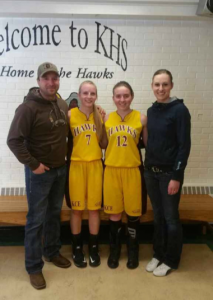
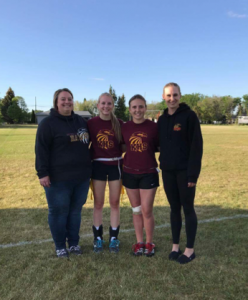
The people who influenced me the most are my teachers/coaches shown above, they played such a big part in my life, always encouraging me to be my best self.
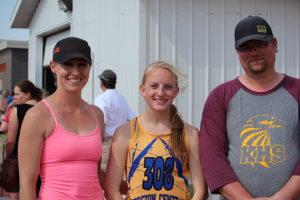
Two individuals who have had the biggest impact on me are shown above, they were my Physical Education teachers in High School. Through the countless hours spent teaching and in the gym coaching me I developed a strong bond with both of them. They both cared for each and every student they taught, and continually inspired me to strive to the best of my ability. They are both role models to me, and I hope as a future educator I can be as dedicated to my career as they are.
Physical education allows children to experience healthy social interactions by teaching cooperation through group activities, and encouraging teamwork through identification as part of a team. These social skills stay with children throughout their lives, developing confidence and contributing to academic growth. My goal is to incorporate the statements below in hopes of creating an environment inclusive of every student.
I hope to one day be able implement these philosophies into my future classroom, developing children that are motivating and excited to be physically active.
As you observed and interacted in your field experiences, how did the focus questions connect with one another? What connections did you make personally and/or professionally to the ‘interconnectedness’ of our weekly topics, field experiences and assignments? How does this experience affect your journey to become a teacher? What do you need to learn more about? What questions do you now have? What are 3 professional goals that you are setting for yourself for your next leg of your journey?
My time during this fieldwork experience in Miss. Johnson’s Kindergarten classroom has taught me a lot about who I want to be as a future educator. As I reflect on the experiences and lessons that I’ve learnt from her I can corroborate that there is so much more to teaching than just showing up to school, working with the kids and going home. Interacting and building relationships especially in younger grades is essential to establishing a core trust system between yourself and your students.
The weekly focus questions really opened my eyes to more of the behind the scene situations that occur in students lives. The atmosphere of a community school definitely added to the uniqueness of every student, and made me think about how teachers also have the added challenge of having to modify lesson plans to specific students. As I reflected weekly the focus questions enabled me to grow as a student, and a future educator. They encouraged me to think outside of the norms that I most accustomed to, and looked at the bigger picture.
These past eight weeks at Elsie Mironuck Community School have really helped in beginning to shape my future teaching identity. It has reinforced to me that teaching is what I want to peruse, but maybe not in an Elementary school. Although I love playing and interacting with younger students, I feel that with my major being in physical education that a secondary classroom is better suited for me.
I have realized from the classes I’ve taken up to this point, and well as this ECS 100 class that there is still so much for me to learn, if I want to a successful teacher. Listening and taking in all the expertise from guest lectures has shown to me how rewarding teaching really is, and how many lives I could have the possibility of impacting with this career.
There are many questions that I still have and I will always be developing more as I grow and learn. Some right now would be:
Three Professional Goals:
Who are your learners? What does the learning environment and classroom look like? Does it remind you of your own schooling? Or is it very different? How does this space make you feel?
I was placed at Elsie Mironuck School in a Kindergarten classroom of thirteen students who are all around the age of five. The learning environment of the classroom was very colourful and interactive, it had many different learning stations that the students got assigned to during a portion of their afternoon. Some of the stations included painting, a laptop with educational games, Lego, kitchen area with play food and a corner designated for reading or looking at books. The classroom was a lot similar to my kindergarten classroom, in that it allowed for the students to be independent but still had rules that were expected to be followed. The students were very excited to have two new faces in the classroom and a lot of them weren’t afraid to give out hugs by the end of the day! I’m looking forward to the rest of my placement with the students and teachers and can’t wait to develop a better understanding of the skills and abilities required of a successful teacher.
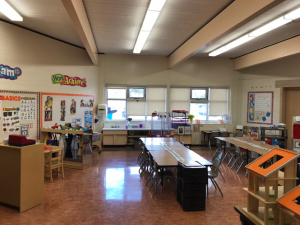

Who are the people in your school? How would describe the school and surrounding community? What and who do you see as creating the links between school and community?
Ecole Elsie Mironuck Community School opened under the name of Sherwood School in 1962. The original building had eight classrooms, additions were added with the growth of northwest Regina in 1964 and 1968 for a completion of 22 classrooms, resource, science and music room. Elsie Mironuck belongs to the Regina Public School Division #4.
Sherwood School was the first school in Regina to have open-area classrooms, participating in the first outdoor school, and was involved in the first team teaching situation. French Immersion was introduced in September of 1980, with 19 Kindergarten students, by 87’ there were 244 students enrolled from Kindergarten to grade 7. Currently Elsie Mironuck unrolls students in Kindergarten to Grade 8 for French Immersion and English Pre-K to Grade 8, with about 600 total students.
Ecole Elsie Mironuck School Community Council is a group of parents, school staff, students, and community members who work together with the school to support the students of the school. The executive council is comprised of 5 main members, the group meets monthly. The council holds an electronics raffle as the main fundraiser for the school, this ensures the schools ability to support programs and make key purchases of different resources for the school.
This week, our day consisted of the same afternoon routine, relaxing time where the students were encouraged to follow along with a 10min GoNoodle video followed by 30min of center time which they were assigned to various play stations. Before recess Miss Johnson read a story that was Halloween themed, and afterwards the students got to tell us what they are being for Halloween. After recess, they have physed and art. For the most part, we don’t interact with other staff members, there is one TA in the classroom with us at all times, and the students have a different physed and art teacher.
The atmosphere of the school is very unique because it is a French Immersion school, both French and English Kindergarten classes seem very familiar with each other and always interact with one another when we switch between physed and art class. The community involvement within the school seems very strong, from reading about the community council that works towards providing the best learning environment for its students, to just the parent interactions with the teachers when they pick up their child up at the end of the day. This week like I said was very similar to last week’s teaching which is expected because it is a Kindergarten classroom, so my partner and I are hoping we can explore different classroom types in the future or possibly sit in during the morning Kindergarten class time.
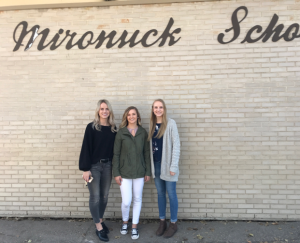
Week Three: Teachers and Knowledge
October 24, 2018How do you see teachers honouring different ways of knowing? How do you see teachers promoting knowledge in the classroom? What are the key supports that teachers rely on? How do teachers continue to build their own professional knowledge?
During my third week at Elsie Mironuck the main focus I’ve noticed in Miss Johnson’s Kindergarten class is repetition, every afternoon when the students come back into the classroom from lunch she does roll-call, every child has to say “good afternoon Miss Johnson” when their name is called otherwise she doesn’t move on. I think this is a great way for students to build a relationship with their teacher as well a way to get some of the more timid/shy students to interact. Going along with the theme of repetition, the structure of the afternoon is always set up in the same way. One way that Miss. Johnson acknowledges good behaviour and understanding of course work is by selecting a “star of the week”, she is always reinforcing to the students to use their manners, be respectful to fellow classmates and proper etiquette in the hallways.
I don’t get to witness a lot of the actual core learning that the students do, because it is all taught in the morning. I’m hoping with potentially going into an older classroom that I’ll be able to experience more of the ways that teachers promote knowledge and how teachers build their own professional knowledge.
What are the different forms of diversity you observe within the classroom and school? What may be some forms of diversity that are not visible? In what ways do you observe the school, classrooms and teachers honouring inclusive practices?
On the first day of my fieldwork at Elsie Mironuck the most preeminent factor that I noticed walking into the school was just how diverse the school really was. I hadn’t done a lot of research about the school before my first day but I did know that it was a community school, so I was prepared for there to be a range of diverse students in my classroom and throughout the school. Being from a small town I was never really exposed to a lot of diverse students; the only real diverse people were either First Nations or Pilipino students. That being said I was exposed to a lot of new experiences my first few weeks of being at the school.
With the school being a French Immersion school it only adds to the diversity and uniqueness of the overall atmosphere. In my Kindergarten classroom, there are four East Indian students, for the most part they are really shy and don’t speak a lot. Some forms of diversity that might not be as visible are the situations that students have to go home to at the end of the day. With Halloween being Wednesday all of the students dressed up except for two students, Miss Johnson spoke to me and my partner about how she sends reminders home with the students but in some cases families can’t afford costumes, or might not celebrate every holiday. This was just one example that got brought up during class, but I’m sure there are many other situations that students have to deal with on a regular basis. Miss Johnson does a great job of including every single student in her classroom, she does a great job of trying to interact with each student during “Centre Time”. During one of the Halloween activities we had a “dance party”, with Halloween themed music, this really showed to me the relationships that were being built between classmates, some of the more outgoing students were trying to engage the shyer students. It was great to see Kindergarten students being so open-minded to interact with other classmates.
How is your school community honouring diversity, equity, and human rights for all students within their schools and communities?
Continuing with the concept of diversity, this week I got to experience the monthly school assemblies for the English half of the school. The other half of the school which is taught French, holds their own separate assemblies. Since being at Elsie Mironuck we haven’t had a lot of interactions with other classrooms or students in the school, we spend the majority of our time in the classroom, therefore attending this afternoon assembly I got to witness how diverse the school really is. As a school, every month they focus on a different goal, the month of November’s was “Responsibility and Self-control”. Within the assembly two grades were responsible for organizing and presenting to the school how their classrooms have been working on improving their roles of being responsible and different methods that can be practiced in everyday life to improve self-control in the classroom as well as at home. I got to witness just how diverse the school was, every classroom had a lot of varying ethnic groups and every child was unique, but every child in the two presenting classes were involved in some way. With the goal of the month, 2-3 students within each grade were recognized for exceeding the expectations, every teacher had the kindest comments about their students and it really showed to me the relationships that have been built.
I’ve noticed that within my Kindergarten classroom that a group of boys tend to be a lot quieter and shyer than the other students but Miss. Johnson does a great job of trying to get them as involved as she can. A few of the more mature students I’ve noticed are always welcoming to include them during play time, showing to me that the diversity doesn’t affect the friendships between students.
What is being taught? How are students learning? Do students see the meaning and relevance in what they are learning? What are the stories of curriculum? What are the stories of learning?
This week my partner and I were able to switch our fieldwork time and attend the morning half of the school day. Going into this new experience I was expecting a lot more curriculum based learning to go on, because we are accustomed to the students having physed and art every afternoon. I know that a lot of what is focused on in Kindergarten is “play” orientated, this gives the children the opportunity to grow and develop the way they learn best. But I thought that at least so kind of formal learning would have taken place. They did very little learning about things that I expected like the alphabet, numbers, animals, or shapes. The parts I can remember from my experiences in Kindergarten involved a lot of working in booklets and learning how to write my name, spelling foundational words, and counting.
The day consisted of learning about how to pronounce and spell the new “star of the weeks” name, and spelling it as a group. They then had station time, followed by an activity that was based around the understanding of what objects in the classroom that were magnetic or not. The students showed great responsibility with the instructions that Miss Johnson gave them, and worked very well with their assigned partners. After snack time and recess, the grade 7/8 class joined us and watched a short 20 min video wrapping up the schools November goal of Responsibility and Self-Control.
Take note of the technologies you see in the classroom and school. Visit the school library…what technology is available for student/teacher use? How are students engaging with technology (in school and outside the school)? Have a discussion with your cooperating teacher to see how he/she uses technology in their instruction, assessment & professional knowledge.
In Miss. Johnsons classroom, some technology is used like a laptop and an overhead projector for the students to follow along with during yoga/relaxation videos. The second use of technology happens in center time, where there is a mini laptop set up with education games for the students to learn about the alphabet, and math games. Not every student gets a chance at using this technology every day, so for the most part technology isn’t a major influencer in the classroom. With it being a Kindergarten classroom there aren’t research projects or assignments that need to be done on the computer like in older grades, I feel this is a factor for not having as many technology outlets for the students. I think the most important learning experiences in Kindergarten is the hands-on play and learning that comes from interacting with teachers and other students. Technology has become a huge part of younger students lives at home and in school, so by Miss. Johnsons classroom not having different devices to be used it allows the kids to be kids and learn and discover through play.